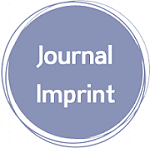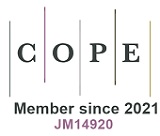Circulating Naturally-Occurring Anticoagulants before Treatment and after Recovery from SARS-CoV-2 Infection in Ghana
Downloads
Doi:10.28991/SciMedJ-2022-04-04-01
Full Text:PDF
Downloads
Cabrera-Garcia, D., Miltiades, A., Parsons, S., Elisman, K., Mansouri, M. T., Wagener, G., & Harrison, N. L. (2021). High levels of plasminogen activator inhibitor-1, tissue plasminogen activator and fibrinogen in patients with severe COVID-19. MedRxiv, 2020.12.29.20248869. doi:10.1101/2020.12.29.20248869.
Vabret, N., Britton, G. J., Gruber, C., Hegde, S., Kim, J., Kuksin, M., Levantovsky, R., Malle, L., Moreira, A., Park, M. D., Pia, L., Risson, E., Saffern, M., Salomé, B., Esai Selvan, M., Spindler, M. P., Tan, J., van der Heide, V., Gregory, J. K., … Laserson, U. (2020). Immunology of COVID-19: Current State of the Science. Immunity, 52(6), 910–941. doi:10.1016/j.immuni.2020.05.002.
Akin, I. M., Kanburoglu, M. K., Tayman, C., Oncel, M. Y., Imdadoglu, T., Dilek, M., ... & Koc, E. (2022). Epidemiologic and clinical characteristics of neonates with late-onset COVID-19: 1-year data of Turkish Neonatal Society. European journal of pediatrics, 181(5), 1933-1942. doi:10.1007/s00431-021-04358-8.
Sonnweber, T., Boehm, A., Sahanic, S., Pizzini, A., Aichner, M., Sonnweber, B., Kurz, K., Koppelstätter, S., Haschka, D., Petzer, V., Hilbe, R., Theurl, M., Lehner, D., Nairz, M., Puchner, B., Luger, A., Schwabl, C., Bellmann-Weiler, R., Wöll, E., … Weiss, G. (2020). Persisting alterations of iron homeostasis in COVID-19 are associated with non-resolving lung pathologies and poor patients’ performance: a prospective observational cohort study. Respiratory Research, 21(1), 1–9. doi:10.1186/s12931-020-01546-2.
Giacomelli, A., Ridolfo, A. L., Milazzo, L., Oreni, L., Bernacchia, D., Siano, M., Bonazzetti, C., Covizzi, A., Schiuma, M., Passerini, M., Piscaglia, M., Coen, M., Gubertini, G., Rizzardini, G., Cogliati, C., Brambilla, A. M., Colombo, R., Castelli, A., Rech, R., … Galli, M. (2020). 30-day mortality in patients hospitalized with COVID-19 during the first wave of the Italian epidemic: A prospective cohort study. Pharmacological Research, 158, 104931. doi:10.1016/j.phrs.2020.104931.
Elderdery, A. Y., Elkhalifa, A. M. E., Alsrhani, A., Zawbaee, K. I., Alsurayea, S. M., Escandarani, F. K., Alhamidi, A. H., Idris, H. M. E., Abbas, A. M., Shalabi, M. G., & Mills, J. (2022). Complete Blood Count Alterations of COVID-19 Patients in Riyadh, Kingdom of Saudi Arabia. Journal of Nanomaterials, 2022. doi:10.1155/2022/6529641.
Hudgins IV, A. F. (2022). Assessing the Prevalence of Anemia Post COVID-19 Infection in Adult Members of a Southeastern Integrated Healthcare System. Master Thesis, Georgia State University, Atlanta, United States. doi:10.57709/29959212.
Zuo, Y., Warnock, M., Harbaugh, A., Yalavarthi, S., Gockman, K., Zuo, M., Madison, J. A., Knight, J. S., Kanthi, Y., & Lawrence, D. A. (2021). Plasma tissue plasminogen activator and plasminogen activator inhibitor-1 in hospitalized COVID-19 patients. Scientific Reports, 11(1). doi:10.1038/s41598-020-80010-z.
Wójcik, K., Bazan-Socha, S., CelejewS.K.A.-Wójcik, N., Górka, K., Lichołai, S., Polok, K., Stachura, T., Zaręba, L., Dziedzic, R., Gradzikiewicz, A., Sanak, M., Musiał, J., Sładek, K., & Iwaniec, T. (2023). Decreased protein C activity, lower ADAMTS13 antigen and free protein S levels accompanied by unchanged thrombin generation potential in hospitalized COVID-19 patients. Thrombosis Research, 223, 80–86. doi:10.1016/j.thromres.2023.01.016.
Kim, H. A., & Kim, J. E. (2022). Development of Nafamostat Mesylate Immediate-Release Tablet by Drug Repositioning Using Quality-by-Design Approach. Pharmaceutics, 14(6), 1219. doi:10.3390/pharmaceutics14061219.
Iba, T., Levy, J. H., Connors, J. M., Warkentin, T. E., Thachil, J., & Levi, M. (2020). The unique characteristics of COVID-19 coagulopathy. Critical Care, 24(1), 1–8. doi:10.1186/s13054-020-03077-0.
Palladino, M. (2021). Complete blood count alterations in covid-19 patients: A narrative review. Biochemia Medica, 31(3), 1–13. doi:10.11613/BM.2021.030501.
Lippi, G., & Plebani, M. (2020). The critical role of laboratory medicine during coronavirus disease 2019 (COVID-19) and other viral outbreaks. Clinical Chemistry and Laboratory Medicine, 58(7), 1063–1069. doi:10.1515/cclm-2020-0240.
Henry, B. M. (2020). COVID-19, ECMO, and lymphopenia: a word of caution. The Lancet Respiratory Medicine, 8(4), e24. doi:10.1016/S2213-2600(20)30119-3.
Mu, T., Yi, Z., Wang, M., Wang, J., Zhang, C., Chen, H., Bai, M., Jiang, L., & Zhang, Y. (2021). Expression of eosinophil in peripheral blood of patients with COVID-19 and its clinical significance. Journal of Clinical Laboratory Analysis, 35(1), 23620. doi:10.1002/jcla.23620.
Conti, P., Ronconi, G., Caraffa, A., Gallenga, C. E., Ross, R., Frydas, I., & Kritas, S. K. (2020). Induction of pro-inflammatory cytokines (IL-1 and IL-6) and lung inflammation by Coronavirus-19 (COVI-19 or SARS-CoV-2): anti-inflammatory strategies. Journal of Biological Regulators and Homeostatic Agents, 34(2), 327–331. doi:10.23812/CONTI-E.
Nkansah, C., Addai-Mensah, O., Mensah, K., Owusu, M., Ephraim, R. K. D., Adu, P., Osei-Boakye, F., Appiah, S. K., Serwaa, D., Derigubah, C. A., & Debrah, A. Y. (2021). Plasminogen Activator Inhibitor-1 in poorly controlled vs well controlled Type-2 Diabetes Mellitus patients: A case-control study in a district hospital in Ghana. PLoS ONE, 16(4 April). doi:10.1371/journal.pone.0250090.
Griffin, J. H., & Lyden, P. (2020). COVID-19 hypothesis: Activated protein C for therapy of virus-induced pathologic thromboinflammation. Research and Practice in Thrombosis and Haemostasis, 4(4), 506–509. doi:10.1002/rth2.12362.
Faggian, G., Bernabei, A., Tropea, I., Francica, A., & Onorati, F. (2023). Hemostasis during cardiopulmonary bypass. In Cardiopulmonary Bypass (pp. 295–309). Academic Press. doi:10.1016/b978-0-443-18918-0.00018-8.
Marchetti, M., Gomez-Rosas, P., Sanga, E., Gamba, S., Verzeroli, C., Russo, L., Restuccia, F., Schieppati, F., Bonanomi, E., Rizzi, M., Fagiuoli, S., D’Alessio, A., Lorini, L., & Falanga, A. (2021). Endothelium Activation Markers in Severe Hospitalized COVID-19 Patients: Role in Mortality Risk Prediction. TH Open, 05(03), e253–e263. doi:10.1055/s-0041-1731711.
Flaumenhaft, R., Enjyoji, K., & Schmaier, A. A. (2022). Vasculopathy in COVID-19. Blood, 140(3), 222–235. doi:10.1182/blood.2021012250.
Corrêa, T. D., Cordioli, R. L., Campos Guerra, J. C., Caldin da Silva, B., dos Reis Rodrigues, R., de Souza, G. M., Midega, T. D., Campos, N. S., Carneiro, B. V., Campos, F. N. D., Guimarães, H. P., de Matos, G. F. J., de Aranda, V. F., & Rolim Ferraz, L. J. (2020). Coagulation profile of COVID-19 patients admitted to the ICU: An exploratory study. PLOS ONE, 15(12), e0243604. doi:10.1371/journal.pone.0243604.
Stoichitoiu, L. E., Pinte, L., Balea, M. I., Nedelcu, V., Badea, C., & Baicus, C. (2020). Anticoagulant protein S in COVID-19: low activity, and associated with outcome. Romanian Journal of Internal Medicine, 58(4), 251–258. doi:10.2478/rjim-2020-0024.
Esmaeel, H. M., Ahmed, H. A., Elbadry, M. I., Khalaf, A. R., Mohammed, N. A., Mahmoud, H. A., & Taha, E. M. (2022). Coagulation parameters abnormalities and their relation to clinical outcomes in hospitalized and severe COVID-19 patients: prospective study. Scientific Reports, 12(1), 13155. doi:10.1038/s41598-022-16915-8.
Goshua, G., Pine, A. B., Meizlish, M. L., Chang, C.-H., Zhang, H., Bahel, P., Baluha, A., Bar, N., Bona, R. D., Burns, A. J., Dela Cruz, C. S., Dumont, A., Halene, S., Hwa, J., Koff, J., Menninger, H., Neparidze, N., Price, C., Siner, J. M., … Lee, A. I. (2020). Endotheliopathy in COVID-19-associated coagulopathy: evidence from a single-centre, cross-sectional study. The Lancet Haematology, 7(8), e575–e582. doi:10.1016/s2352-3026(20)30216-7.
Al-Kuraishy, H. M., Al-Gareeb, A. I., Al-Harcan, N. A. H., Alexiou, A., & Batiha, G. E.-S. (2022). Tranexamic Acid and Plasminogen/Plasmin Glaring Paradox in COVID-19. Endocrine, Metabolic & Immune Disorders - Drug Targets, 23(1), 35–45. doi:10.2174/1871530322666220801102402.
McConnell, M. J., Kondo, R., Kawaguchi, N., & Iwakiri, Y. (2022). Covid-19 and Liver Injury: Role of Inflammatory Endotheliopathy, Platelet Dysfunction, and Thrombosis. Hepatology Communications, 6(2), 255–269. doi:10.1002/hep4.1843.
Panigada, M., Bottino, N., Tagliabue, P., Grasselli, G., Novembrino, C., Chantarangkul, V., Pesenti, A., Peyvandi, F., & Tripodi, A. (2020). Hypercoagulability of COVID-19 patients in intensive care unit: A report of thromboelastography findings and other parameters of hemostasis. Journal of Thrombosis and Haemostasis, 18(7), 1738–1742. doi:10.1111/jth.14850.
Yasmine, H. O., Emmanuel, O., Kwaku, D. G., James, A.-D., & Rita, L.-R. (2022). COVID-19 Associated Pulmonary Thromboembolic Events in Anti-Coagulated Patients: Case Series from a Tertiary Facility in Ghana. Medical and Clinical Case Reports, 2(1). doi:10.33425/2768-6647.1017.
Adu, C., Mensah, K. A., Ahinkorah, B. O., Osei, D., Tetteh, A. W., & Seidu, A. A. (2022). Socio-demographic factors associated with medication adherence among People Living with HIV in the Kumasi Metropolis, Ghana. AIDS Research and Therapy, 19(1), 50. doi:10.1186/s12981-022-00474-z.
Voicu, S., Bonnin, P., Stépanian, A., Chousterman, B. G., Le Gall, A., Malissin, I., Deye, N., Siguret, V., Mebazaa, A., & Mégarbane, B. (2020). High Prevalence of Deep Vein Thrombosis in Mechanically Ventilated COVID-19 Patients. Journal of the American College of Cardiology, 76(4), 480–482. doi:10.1016/j.jacc.2020.05.053.
World Health Organization (WHO). (2022). Clinical management of COVID-19: Living guideline. World Health Organization (WHO), Geneva, Switzerland.
Osei-Boakye, F., Addai-Mensah, O., Owusu, M., Saasi, A. R., Appiah, S. K., Nkansah, C., Wiafe, Y. A., & Debrah, A. Y. (2022). Effect of pulmonary tuberculosis on natural anticoagulant activity in therapy-naïve Ghanaian adults; a case-control study. Journal of Immunoassay and Immunochemistry, 43(3), 271–287. doi:10.1080/15321819.2021.2001002.
Chauhan, S., Kumar, P., Marbaniang, S. P., Srivastava, S., & Patel, R. (2022). Prevalence and predictors of anaemia among adolescents in Bihar and Uttar Pradesh, India. Scientific Reports, 12(1), 1–9 8197. doi:10.1038/s41598-022-12258-6.
Struyf, T., Deeks, J. J., Dinnes, J., Takwoingi, Y., Davenport, C., Leeflang, M. M., Spijker, R., Hooft, L., Emperador, D., Dittrich, S., Domen, J., Horn, S. R. A., & Van den Bruel, A. (2020). Signs and symptoms to determine if a patient presenting in primary care or hospital outpatient settings has COVID-19 disease. Cochrane Database of Systematic Reviews. doi:10.1002/14651858.cd013665.
Sadoff, J., Gray, G., Vandebosch, A., Cárdenas, V., Shukarev, G., Grinsztejn, B., Goepfert, P. A., Truyers, C., Van Dromme, I., Spiessens, B., Vingerhoets, J., Custers, J., Scheper, G., … Douoguih, M. (2022). Final Analysis of Efficacy and Safety of Single-Dose Ad26.COV2.S. New England Journal of Medicine, 386(9), 847–860. doi:10.1056/nejmoa2117608.
Xu, P., Zhou, Q., & Xu, J. (2020). Mechanism of thrombocytopenia in COVID-19 patients. Annals of Hematology, 99(6), 1205–1208. doi:10.1007/s00277-020-04019-0.
Gul, M. H., Htun, Z. M., & Inayat, A. (2021). Role of fever and ambient temperature in COVID-19. Expert Review of Respiratory Medicine, 15(2), 171–173. doi:10.1080/17476348.2020.1816172.
Caruso, P. F., Angelotti, G., Greco, M., Albini, M., Savevski, V., Azzolini, E., Briani, M., Ciccarelli, M., Aghemo, A., Kurihara, H., Voza, A., Badalamenti, S., Lagioia, M., & Cecconi, M. (2022). The effect of COVID-19 epidemic on vital signs in hospitalized patients: a pre-post heat-map study from a large teaching hospital. Journal of Clinical Monitoring and Computing, 36(3), 829–837. doi:10.1007/s10877-021-00715-y.
Konlaan, Y., Asamoah Sakyi, S., Kumi Asare, K., Amoah Barnie, P., Opoku, S., Nakotey, G. K., Victor Nuvor, S., & Amoani, B. (2022). Evaluating immunohaematological profile among COVID-19 active infection and recovered patients in Ghana. PLOS ONE, 17(9), e0273969. doi:10.1371/journal.pone.0273969.
Attoh, S. A., Sarkodie, E., Fatchu, R., Kuma, A. B. A., Asumanu, E., McAddy, M., Toppar, A., Hobenu, F., Agyeman-Bediako, K., Edusei, L., & Akakpo, P. K. (2022). COVID-19 and sickle cell disease: autopsy findings of three deaths at the 37 Military Hospital, Accra, Ghana. Pan African Medical Journal, 41. doi:10.11604/pamj.2022.41.332.30035.
Wang, L., Duan, Y., Zhang, W., Liang, J., Xu, J., Zhang, Y., Wu, C., Xu, Y., & Li, H. (2020). Epidemiologic and clinical characteristics of 26 cases of covid-19 arising from patient-to-patient transmission in liaocheng, china. Clinical Epidemiology, 12, 387–391. doi:10.2147/CLEP.S249903.
Tao, Z., Xu, J., Chen, W., Yang, Z., Xu, X., Liu, L., Chen, R., Xie, J., Liu, M., Wu, J., Wang, H., & Liu, J. (2021). Anemia is associated with severe illness in COVID-19: A retrospective cohort study. Journal of Medical Virology, 93(3), 1478–1488. doi:10.1002/jmv.26444.
Huang, Y., Tu, M., Wang, S., Chen, S., Zhou, W., Chen, D., Zhou, L., Wang, M., Zhao, Y., Zeng, W., Huang, Q., Xu, H., Liu, Z., & Guo, L. (2020). Clinical characteristics of laboratory confirmed positive cases of SARS-CoV-2 infection in Wuhan, China: A retrospective single center analysis. Travel Medicine and Infectious Disease, 36. doi:10.1016/j.tmaid.2020.101606.
Lanser, L., Burkert, F. R., Bellmann-Weiler, R., Schroll, A., Wildner, S., Fritsche, G., & Weiss, G. (2021). Dynamics in anemia development and dysregulation of iron homeostasis in hospitalized patients with covid-19. Metabolites, 11(10). doi:10.3390/metabo11100653.
Lanser, L., Fuchs, D., Kurz, K., & Weiss, G. (2021). Physiology and inflammation driven pathophysiology of iron homeostasis—mechanistic insights into anemia of inflammation and its treatment. Nutrients, 13(11). doi:10.3390/nu13113732.
Weiss, G., Ganz, T., & Goodnough, L. T. (2019). Anemia of inflammation. Blood, 133(1), 40–50. doi:10.1182/blood-2018-06-856500.
Yan, W., Chen, D., Bigambo, F. M., Wei, H., Wang, X., & Xia, Y. (2021). Differences of blood cells, lymphocyte subsets and cytokines in COVID-19 patients with different clinical stages: a network meta-analysis. BMC Infectious Diseases, 21(1). doi:10.1186/s12879-021-05847-9.
Chatterjee, S., Sengupta, T., Majumder, S., & Majumder, R. (2020). COVID-19: A probable role of the anticoagulant Protein S in managing COVID-19-associated coagulopathy. Aging, 12(16), 15954–15961. doi:10.18632/aging.103869.
Afriyie-Mensah, J., Aboagye, E. T., Ganu, V. J., Bondzi, S., Tetteh, D., Kwarteng, E., Akamah, J., Doku, A., & Adjei, P. (2021). Clinical and therapeutic outcomes of covid-19 intensive care units (Icu) patients: A retrospective study in ghana. Pan African Medical Journal, 38, 38. doi:10.11604/pamj.2021.38.107.27131.
Asrie, F., Tekle, E., Gelaw, Y., Dagnew, M., Gelaw, A., Negash, M., Kassa, E., Bizuneh, S., & Wudineh, D. (2022). Baseline Thrombocytopenia and Disease Severity Among COVID-19 Patients, Tibebe Ghion Specialized Hospital COVID-19 Treatment Center, Northwest Ethiopia. Journal of Blood Medicine, 13, 315–325. doi:10.2147/JBM.S366478.
Ropa, J., Cooper, S., Capitano, M. L., Van’t Hof, W., & Broxmeyer, H. E. (2021). Human Hematopoietic Stem, Progenitor, and Immune Cells Respond Ex Vivo to SARS-CoV-2 Spike Protein. Stem Cell Reviews and Reports, 17(1), 253–265. doi:10.1007/s12015-020-10056-z.
Ropa, J., Trinh, T., Aljoufi, A., & Broxmeyer, H. E. (2021). Consequences of coronavirus infections for primitive and mature hematopoietic cells: New insights and why it matters. Current Opinion in Hematology, 28(4), 231–242. doi:10.1097/MOH.0000000000000645.
Iba, T., Levy, J. H., Levi, M., Connors, J. M., & Thachil, J. (2020). Coagulopathy of Coronavirus Disease 2019. Critical Care Medicine, 48(9), 1358–1364. doi:10.1097/CCM.0000000000004458.
Wool, G. D., & Miller, J. L. (2021). The Impact of COVID-19 Disease on Platelets and Coagulation. Pathobiology, 88(1), 15–27. doi:10.1159/000512007.
Ranucci, M., Ballotta, A., Di Dedda, U., Bayshnikova, E., Dei Poli, M., Resta, M., Falco, M., Albano, G., & Menicanti, L. (2020). The procoagulant pattern of patients with COVID-19 acute respiratory distress syndrome. Journal of Thrombosis and Haemostasis, 18(7), 1747–1751. doi:10.1111/jth.14854.
Boettler, T., Newsome, P. N., Mondelli, M. U., Maticic, M., Cordero, E., Cornberg, M., & Berg, T. (2020). Care of patients with liver disease during the COVID-19 pandemic: EASL-ESCMID position paper. JHEP Reports, 2(3), 100113. doi:10.1016/j.jhepr.2020.100113.
Sun, J., Aghemo, A., Forner, A., & Valenti, L. (2020). COVID-19 and liver disease. Liver International, 40(6), 1278–1281. doi:10.1111/liv.14470.
Bellmann-Weiler, R., Lanser, L., Barket, R., Rangger, L., Schapfl, A., Schaber, M., Fritsche, G., Wöll, E., & Weiss, G. (2020). Prevalence and predictive value of anemia and dysregulated iron homeostasis in patients with COVID-19 infection. Journal of Clinical Medicine, 9(8), 1–11. doi:10.3390/jcm9082429.
Liang, J., Nong, S., Jiang, L., Chi, X., Bi, D., Cao, J., Mo, L., Luo, X., & Huang, H. (2021). Correlations of disease severity and age with hematology parameter variations in patients with COVID-19 pre- and post-treatment. Journal of Clinical Laboratory Analysis, 35(1), 23609. doi:10.1002/jcla.23609.
- This work (including HTML and PDF Files) is licensed under a Creative Commons Attribution 4.0 International License.












